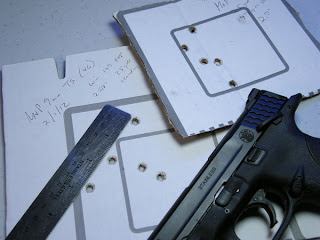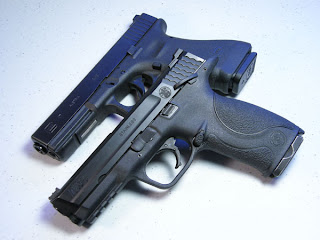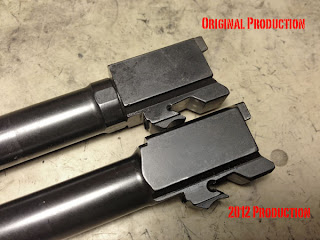I'm coming in a bit late to the recent flurry of blog posts about this debate, but figured I'd weigh in with my own unique technical point of view. Our friend Shelley at Gunnuts.net kicked this off with her take on the M&P vs. Glock, which was then followed up by a rebuttal on Vuurwapenblog, and finally by my good buddy Tim on his 10-8 Training blog.
Readers of this blog and the 10-8 Performance Facebook page are no strangers to my affection for the M&P. I was one of the earliest adopters of the platform, and was hooked ever since I fired one of the prototypes in the basement of the S&W factory back in 2005 or so. I have also been shooting Glocks since the 90's, and have a number of them in the pile as well, so I can speak with experience on both. With so many compelling empirical arguments in favor of the Glock 17, why am I shooting a M&P 9mm?
For purposes of discussion below, I will be comparing the Glock 17 vs. the M&P 9mm full sized model. If we were comparing the Glock 21 to the M&P 45, then let's just stop here and declare the M&P .45 the winner and move on. Superior ergonomics by far, good accuracy, and availability of thumb safety to help transition 1911 shooters make the M&P 45 the clear winner in my opinion. Add a viable and reliable factory 14 round magazine, and you pretty much have the whole package wrapped up with a bow. Same with .40 - the M&P was designed for the .40, with steel chassis for increased rigidity and none of the durability or function issues of the Glock 22. Oddly, the 9mm was shoehorned into the M&P platform rather than the reverse which is true for Glock, and it is therefore the weakest model of the M&P. So why do I shoot one all the time?
- The main downfall of the M&P 9mm is the wildly varying accuracy thanks to some QC issues and design flaws. The M&P 9 barrel uses a tragically slow 1:18.75" twist, which does a poor job stabilizing heavier bullets. To add insult to injury, the M&P also unlocks extremely quickly. This early unlocking tends to negate any conventional wisdom on what bullet weights should shoot well with the M&P, and you'll want to do a bit of experimenting. The Glock is inherently more accurate than the M&P, and will shoot 3" or better at 25 yards with a wide range of ammunition. I feel that 3" or less is a good measure for service pistol accuracy at 25 yards. My 3 primary M&P 9mm's will all shoot 3" or better at 25 yards with any 147 grain ammunition that I feed them, and two of them have printed 2 5/8" standing offhand at 25 yards with 147 grain. That works for me. However, all three of the guns shoot about 6-8" at 25 yards using 115 and 124 grain ammo. My solution at this point is just to stick with 147 grain.
 |
| 25 yd standing offhand groups with M&P 9 |
- I feel that the M&P ergonomics are far superior for a 1911 guy, and better thought out overall than Glock (even the Gen 4). The availability of interchangeable backstraps and thumb safety make the M&P a very logical polymer substitute for a 1911. I love my M&P 9's light recoil and lack of maintenance and setup requirements, making it a great vacation from high maintenance/setup 1911s.
- Reliability? The 3rd Gen Glock 17 is an extremely reliable gun, but it's a real crapshoot right now with the Gen 4. The M&P 9mm tends to be quite reliable across the board, and my 3 guns have not had any weapon related malfunctions in about 9000 rounds since the end of October 2011. I have isolated some real bad primers in some of my ammo that have given me failures to fire, and had a total of 2 magazine related failures which were tracked down to a bad follower and worn spring in one mag. That mag has been rebuilt and has since been 100%.
- The factory Glock trigger is usable and consistent, which is one of its other strong points. However, my Lyman digital trigger pull gauge tells me that the advertised standard 5.5 lb Glock trigger pull must not include a free bonus weight of anywhere from 1-3 pounds on various samples I have on hand. Aftermarket parts may yield a lighter pull, but with an indistinct break that is still somewhat spongy. My M&P's are mostly set up with the awesome Apex Tactical components, making for a true 4.0 lbs even on my digital gauge. Stock M&P's often have a crunchy take-up due to stamping marks on the trigger bow, but tend to smooth up well with use. The quality of the sear/striker engagement is typically pretty decent, and I have a couple guns that I shoot with the stock engagement (about 6-6.5 lbs) with no detriment in performance. Even with aftermarket parts in both guns, the potential for an excellent trigger has the M&P far exceeding the Glock's potential. The Glock trigger has a superior reset, but I feel that the value of a big clicky reset is overstated. Remember that the break is what lets you shoot well, not the reset.
- I like the M&P's steel mags, they are easy to disassemble, and the current polymer finish on them is very good.
- The M&P is faster and more consistent to speed reload, with no ledges or cavities to catch the incoming magazine.
- The grip angle issue is moot, I switch between my SIRT training pistol (which is basically a Glock 17) and M&P without even noticing. I will even do this in live fire, alternating dry runs with the SIRT, then immediately running a live fire run with the M&P. Whatever grip angle you prefer is the correct answer.
- S&W customer service is exceptional.
So that's why I shoot the M&P. I am not blind to its faults, but I have figured out how to work around all of them, and really enjoy the platform. With aftermarket enhancements, the M&P jumps ahead by leaps and bounds. In time, I see the production M&P gaining even more ground on the Glock and getting the various weaknesses corrected. With the M&P, I am also pleased to see an American made gun from an American manufacturer start to work its way into the holsters of American law enforcement.
Which gun do you prefer? Let us know in the comments section.
























